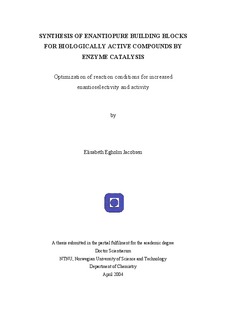| dc.contributor.author | Jacobsen, Elisabeth Egholm | nb_NO |
| dc.date.accessioned | 2014-12-19T13:20:36Z | |
| dc.date.available | 2014-12-19T13:20:36Z | |
| dc.date.created | 2008-04-14 | nb_NO |
| dc.date.issued | 2004 | nb_NO |
| dc.identifier | 124083 | nb_NO |
| dc.identifier.isbn | 82-471-6307-1 | nb_NO |
| dc.identifier.uri | http://hdl.handle.net/11250/247447 | |
| dc.description.abstract | Efficient methods for synthesis of enantiomerically pure enantiomers of a series of secondary alcohols and butanoates have been performed by kinetic resolution of the racemic alcohols and esters catalyzed by lipase B from Candida antarctica (Novozym 435). The effect of the substrate structure on E was different for transesterifications of alcohols in organic media as compared to hydrolysis of esters in buffer. The influence of different acyl donors on the enantioselectivity has also been investigated.
Derivatives of 1-phenoxy-2-alkanols have been kinetically resolved by esterification with irreversible and reversible acyl donors using lipase B from Candida antarctica (Novozym 435) as catalyst. Esterifications in eight different solvents with different water activity have been performed. For 3-bromo-1-phenoxy-2-propanol the E-values in all of the solvents were higher when the water activity was increased. The water content of the various reaction media at the same water activity was also determined.
In esterifications of secondary alcohols catalyzed by immobilized lipase B from Candida antarctica (Novozym 435) the E-values decreased during the reaction. Hydrolysis of the corresponding butanoates showed the opposite effect. When an enantiopure (R)-alcohol, related but different, was added to the transesterification reaction, the E-value was significantly enhanced.
Decreasing enantioselectivity (E-value) by conversion has also been observed in transesterification reactions of secondary alcohols catalyzed by a pure protein formulation of lipase B from Candida antarctica (Novozym 525 F). It can be concluded that the immobilization of Novozym 435 not was the reason for the decrease in E-value which was observed. Addition of a range of enantiopure alcohols caused a temporary increase in enzyme selectivity in the transesterification reaction of 3-chloro-1-phenoxy- 2-propanol with vinyl butanoate.
Enantioselective hydrolyses and ammonolyses of diethyl 3-hydroxyglutarate and dimethyl 3-hydroxyglutarate gave a maximum of 91 and 98 % enantiomeric excess, respectively, with use of immobilized lipase B from Candida antarctica (Novozym 435). Ee´s were determined using chiral GLC of the mono amides and achiral GLC of diastereomeric derivatives of the monoesters. The catalyst was re-used more than ten times with retention of high activity and selectivity.
Biocatalytic asymmetrizations of diethyl 3-hydroxyglutarate furnish a route to enantiomers of ethyl 4-cyano-3-hydroxybutanoate. The enantiopreference of different enzymes has been established by chiral chromatography. Conclusive evidence for absolute configurations has been provided by X-ray crystallographic structure determination of co-crystals of the predominant monoester (3S)-3-hydroxy pentanedioic monoethyl ester with (R)-phenylethylamine. The predominant enantiopure monoester produced by ammonolysis of diethyl 3-hydroxyglutarate catalyzed by immobilized lipase B from Candida antarctica (Novozym 435) was ethyl (3S)-4-carbamoyl-3- hydroxybutanoate. It was converted to ethyl (3S)-4-cyano-3-hydroxybutanoate in high yield and enantiomeric excess. | nb_NO |
| dc.language | eng | nb_NO |
| dc.publisher | Fakultet for naturvitenskap og teknologi | nb_NO |
| dc.relation.ispartofseries | Doktoravhandlinger ved NTNU, 1503-8181; 2004:50 | nb_NO |
| dc.relation.haspart | Jacobsen, Elisabeth Egholm; Hoff, Bård Helge; Anthonsen, Thorleif. Enantiopure derivatives of 1,2-alkanediols: Substrate requirements of lipase B from Candida antarctica. Chirality. 12(9): 654-659, 2000. | nb_NO |
| dc.relation.haspart | Jacobsen, Elisabeth Egholm; Anthonsen, Thorleif. Water content influences the selectivity of CALB-catalyzed kinetic resolution of phenoxymethyl-substituted secondary alcohols. Can. J. Chem. 80(6): 577-581, 2002. | nb_NO |
| dc.relation.haspart | Jacobsen, Elisabeth Egholm; van Hellemond, Erik; Moen, Anders Riise; Prado, Lucia Camino Vazquez; Anthonsen, Thorleif. Enhanced selectivity in Novozym 435 catalyzed kinetic resolution of secondary alcohols and butanoates caused by the (R)-alcohols. Tetrahedron Letters. 44(46): 8453-8455, 2003. | nb_NO |
| dc.relation.haspart | Jacobsen, Elisabeth Egholm; Andresen, Liv Siri; Anthonsen, Thorleif. Immobilization does not influence the enantioselectivity of CAL-B catalyzed kinetic resolution of secondary alcohols. Tetrahedron: Asymmetry. 16(4): 847-850, 2005. | nb_NO |
| dc.relation.haspart | Jacobsen, Elisabeth Egholm; Hoff, Bård Helge; Moen, Anders Riise; Anthonsen, Thorleif. Enantioselective enzymatic preparation of chiral glutaric monocarboxylic acids and amides. Journal of Molecular Catalysis B: Enzymatic. 21(1-2): 55-58, 2003. | nb_NO |
| dc.relation.haspart | Moen, Anders Riise; Hoff, Bård Helge; Hansen, Lars Kristian; Anthonsen, Thorleif; Jacobsen, Elisabeth Egholm. Absolute configurations of monoesters produced by enzyme catalyzed hydrolysis of diethyl 3-hydroxyglutarate. Tetrahedron: Asymmetry. 15(10): 1551-1554, 2004. | nb_NO |
| dc.relation.haspart | Tjosås, Freddy; Anthonsen, Thorleif; Jacobsen, Elisabeth Egholm. Biocatalytic resolution of saphenic acid. Substrate preferences for lipases A and B from Candida antarctica. Arkivoc(vi): 81-90, 2008. | nb_NO |
| dc.title | Synthesis of enantiopure building blocks for biologically active compounds by enzyme catalysis. Optimizing reaction conditions for increased enantioselectivity and activity | nb_NO |
| dc.type | Doctoral thesis | nb_NO |
| dc.contributor.department | Norges teknisk-naturvitenskapelige universitet, Fakultet for naturvitenskap og teknologi, Institutt for kjemi | nb_NO |
| dc.description.degree | dr.scient. | nb_NO |
| dc.description.degree | dr.scient. | en_GB |
